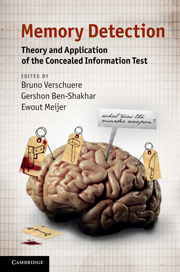Book contents
- Frontmatter
- Contents
- List of figures
- List of tables
- Notes on contributors
- Acknowledgments
- Part I Introduction
- Part II The laboratory: theoretical and empirical foundations of the Concealed Information Test
- 2 Detecting concealed information using autonomic measures
- 3 Detecting concealed information in less than a second: response latency-based measures
- 4 P300 in detecting concealed information
- 5 Detecting of deception and concealed information using neuroimaging techniques
- 6 New and old covert measures in the Concealed Information Test
- 7 Theory of the Concealed Information Test
- Part III Field applications of concealed information detection: promises and perils
- Part IV Conclusions
- Index
- References
2 - Detecting concealed information using autonomic measures
Published online by Cambridge University Press: 05 June 2012
- Frontmatter
- Contents
- List of figures
- List of tables
- Notes on contributors
- Acknowledgments
- Part I Introduction
- Part II The laboratory: theoretical and empirical foundations of the Concealed Information Test
- 2 Detecting concealed information using autonomic measures
- 3 Detecting concealed information in less than a second: response latency-based measures
- 4 P300 in detecting concealed information
- 5 Detecting of deception and concealed information using neuroimaging techniques
- 6 New and old covert measures in the Concealed Information Test
- 7 Theory of the Concealed Information Test
- Part III Field applications of concealed information detection: promises and perils
- Part IV Conclusions
- Index
- References
Summary
Overview: Already in the first empirical demonstration of the Concealed Information Test (CIT), it was shown that electrodermal responses can be used to detect concealed knowledge with high accuracy. This chapter summarizes the huge number of studies on autonomic measures in the CIT that have been conducted in the last decades. Taken together, it is now well established that the recognition of crime-related items results in larger skin conductance responses, respiratory suppression, heart rate deceleration and reductions of pulse volume amplitudes when compared to neutral control items. This response pattern results from a coactivation of the sympathetic and the vagal branch of the autonomic nervous system and it is at least in part related to the orienting response. Recent studies have shown that the validity of the CIT can be further increased by systematically combining electrodermal, respiratory and heart rate responses by means of a logistic classification function. Finally, important questions for future research on autonomic measures in the CIT are outlined.
Introduction
More than fifty years ago, Lykken (1959) demonstrated that phasic skin conductance changes can be used to detect concealed knowledge with high validity. In this influential study, four groups of participants were examined. One group was asked to commit two mock crimes (a murder and a theft), thereby gaining knowledge of several crime-related details. Two more groups carried out only one of these mock crimes while remaining ignorant to the relevant details of the other scenario and a fourth group was exposed to neither of these mock crimes.
Information
- Type
- Chapter
- Information
- Memory DetectionTheory and Application of the Concealed Information Test, pp. 27 - 45Publisher: Cambridge University PressPrint publication year: 2011
References
Accessibility standard: Unknown
Why this information is here
This section outlines the accessibility features of this content - including support for screen readers, full keyboard navigation and high-contrast display options. This may not be relevant for you.Accessibility Information
- 25
- Cited by
